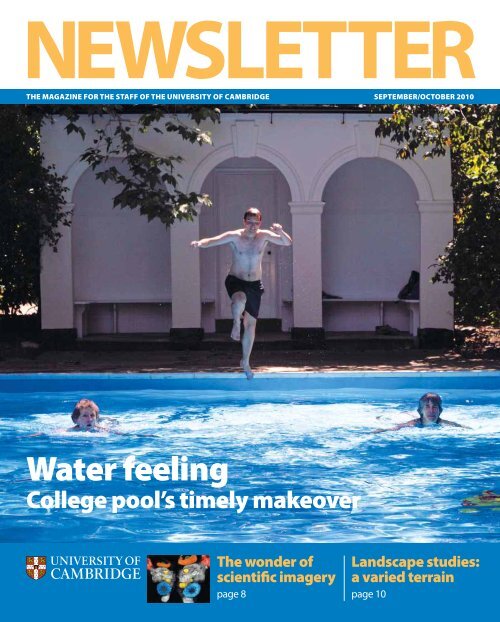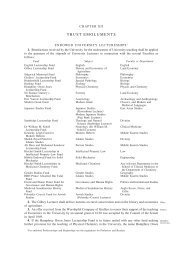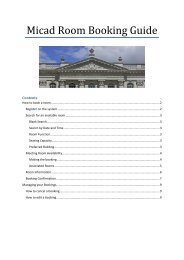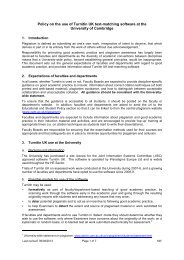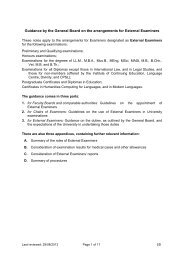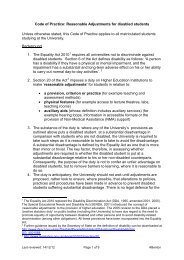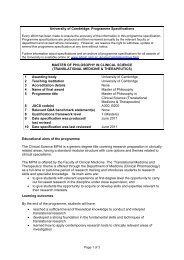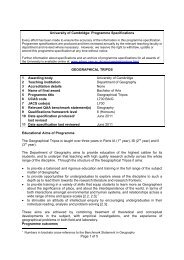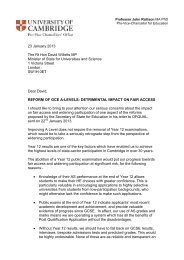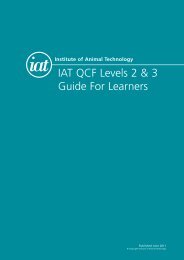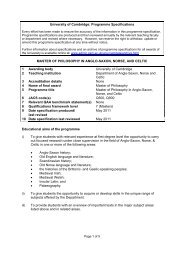Water feeling - the University Offices - University of Cambridge
Water feeling - the University Offices - University of Cambridge
Water feeling - the University Offices - University of Cambridge
You also want an ePaper? Increase the reach of your titles
YUMPU automatically turns print PDFs into web optimized ePapers that Google loves.
The magazine for The sTaff <strong>of</strong> The UniversiTy <strong>of</strong> <strong>Cambridge</strong> sepTember/oCTober 2010<br />
<strong>Water</strong> <strong>feeling</strong><br />
College pool’s timely makeover<br />
The wonder <strong>of</strong><br />
scientific imagery<br />
page 8<br />
Landscape studies:<br />
a varied terrain<br />
page 10
snapshoT<br />
Hot shot: This picture was one <strong>of</strong><br />
165 entries to <strong>the</strong> 2010 Engineering<br />
Department photo competition. Taken<br />
by student Nate Sharpe, it shows a rifle<br />
bullet slicing through a playing card, and<br />
was taken with a flash <strong>of</strong> 400 billionths<br />
<strong>of</strong> a second. The competition, which<br />
was won by Dr Robert Gordon, invites<br />
anyone who works in <strong>the</strong> department<br />
– whe<strong>the</strong>r academic, student or<br />
member <strong>of</strong> supporting staff – to submit<br />
a photograph connected with <strong>the</strong>ir<br />
everyday work.<br />
open again: The last letters <strong>of</strong> Captain<br />
Scott and his companions have returned<br />
to public display as one <strong>of</strong> <strong>the</strong> world’s<br />
most important collections <strong>of</strong> polar<br />
artefacts was opened by <strong>the</strong> Earl and<br />
Countess <strong>of</strong> Wessex. The Polar Museum at<br />
<strong>the</strong> Scott Polar Research Institute – which<br />
also holds <strong>the</strong> expedition diaries <strong>of</strong> Sir<br />
Ernest Shackleton and <strong>the</strong> photographic<br />
records <strong>of</strong> Herbert Ponting – has<br />
undergone a two-year transformation as<br />
part <strong>of</strong> a £1.75m redevelopment.<br />
sassoon exhibition: The treasures <strong>of</strong><br />
Siegfried Sassoon’s personal archive have<br />
gone on public display for <strong>the</strong> first time<br />
at <strong>the</strong> <strong>University</strong> Library. Exhibits include<br />
his diary recounting <strong>the</strong> first day at <strong>the</strong><br />
Battle <strong>of</strong> <strong>the</strong> Somme, and this ligh<strong>the</strong>arted<br />
sketch by <strong>the</strong> poet <strong>of</strong> a memorial<br />
he wanted erected to him on Market<br />
Hill, <strong>Cambridge</strong>. ‘Dream Voices: Siegfried<br />
Sassoon, Memory and War’, runs until<br />
23 December. The archive was bought<br />
by <strong>the</strong> library after a £1.25m fundraising<br />
campaign.<br />
Access all areas: Newnham College,<br />
pictured, was one <strong>of</strong> <strong>the</strong> many venues<br />
and institutions that opened <strong>the</strong>ir doors<br />
to <strong>the</strong> public this month as part <strong>of</strong> Open<br />
<strong>Cambridge</strong>. The weekend included<br />
tours, walks and open access events that<br />
allowed local residents and community<br />
groups to experience <strong>the</strong> <strong>University</strong><br />
and city’s rich heritage. This year saw a<br />
number <strong>of</strong> activities targeted specifically<br />
at families and children.<br />
2 | september/october 2010 | UNIVERSITY OF CAMBRIDGE NEwSlETTER<br />
ConTenTs<br />
cover<br />
Generous alumni have<br />
saved Christ’s historic<br />
bathing pool.<br />
Turn to page 4<br />
2-5 News round-up<br />
6-7 Getting practical<br />
It started with an item in <strong>the</strong> Newsletter –<br />
now former staff member An<strong>the</strong>a Bain is<br />
a student at <strong>the</strong> <strong>University</strong><br />
8-9 behind <strong>the</strong> scenes<br />
How <strong>Cambridge</strong> researchers and<br />
technicians are creating some <strong>of</strong> science’s<br />
most stunning pictures<br />
10-11 making a difference<br />
Landscape studies can help us<br />
understand <strong>the</strong> past – and shape<br />
our future<br />
12-13 prizes, awards and honours<br />
14 obituary<br />
15 Advertisements<br />
<strong>Water</strong> <strong>feeling</strong><br />
College pool’s timely makeover<br />
neWsLeTTer<br />
The Newsletter is published for <strong>the</strong> staff <strong>of</strong> <strong>the</strong><br />
<strong>University</strong> <strong>of</strong> <strong>Cambridge</strong> and is produced by <strong>the</strong><br />
Office <strong>of</strong> External Affairs and Communications.<br />
Please send in ideas for <strong>the</strong> content and ways<br />
we can improve <strong>the</strong> publication.<br />
Tel: (3)32300 or email newsletter@admin.cam.ac.uk.<br />
Suggestions for articles for <strong>the</strong> November/<br />
December edition should reach <strong>the</strong> Editor by<br />
1 October.<br />
Editor: Andrew Aldridge<br />
Advertising: Nick Saffell<br />
Design: www.creative-warehouse.co.uk<br />
Printers: Labute Printers<br />
Contributors: Andrew Aldridge, Becky Allen,<br />
Alex Buxton, Abbie Long, Stuart Roberts.<br />
neWsLeTTer onLine<br />
www.admin.cam.ac.uk/univ/newsletter<br />
The magazine for The sTaff <strong>of</strong> The UniversiTy <strong>of</strong> <strong>Cambridge</strong> sepTember/oCTober 2010<br />
The wonder <strong>of</strong> Landscape studies:<br />
scientific imagery a varied terrain<br />
page 8<br />
page 10
WhaT’s neW<br />
vice-Chancellor<br />
becomes dame alison<br />
VICE-CHANCELLOR PROFESSOR<br />
Alison Richard has been appointed<br />
Dame Commander <strong>of</strong> <strong>the</strong> British<br />
Empire for services to higher<br />
education.<br />
The announcement was made in<br />
<strong>the</strong> Queen’s Birthday Honours list.<br />
During her seven-year term as<br />
Vice-Chancellor, which concludes at<br />
<strong>the</strong> end <strong>of</strong> this month, she has argued<br />
consistently for deliberate diversity <strong>of</strong><br />
mission in UK higher education.<br />
Dame Alison has overseen<br />
<strong>the</strong> establishment <strong>of</strong> needsbased<br />
bursaries to ensure that<br />
undergraduate students and<br />
applicants can always afford to study<br />
at <strong>Cambridge</strong>, and she has supported<br />
major teaching and research<br />
initiatives across academic disciplines.<br />
Her term <strong>of</strong> <strong>of</strong>fice has also seen <strong>the</strong><br />
development <strong>of</strong> alumni as advisers<br />
THE CAMBRIDGE FESTIVAL <strong>of</strong> Ideas<br />
returns next month, giving visitors<br />
<strong>the</strong> chance to experience a huge<br />
range <strong>of</strong> talks and workshops.<br />
The 11-day festival, which runs<br />
from 20-31 October, celebrates <strong>the</strong><br />
arts, humanities and social sciences.<br />
This year’s guest speakers include <strong>the</strong><br />
children’s author Jacqueline Wilson<br />
and The Guardian columnist Lucy<br />
Mangan.<br />
The festival’s flagship event, <strong>the</strong><br />
annual Mark Pigott Lecture, will be<br />
delivered this year by Pr<strong>of</strong>essor Linda<br />
Colley, who will speak on <strong>the</strong> subject<br />
‘When did <strong>the</strong> British Constitution<br />
become unwritten?’. Pr<strong>of</strong>essor Colley<br />
is a British historian whose 1992<br />
study Britons: Forging <strong>the</strong> Nation,<br />
1707–1837 explored <strong>the</strong> development<br />
<strong>of</strong> Britishness following <strong>the</strong> 1707 Acts<br />
<strong>of</strong> Union. She is Shelby M C Davis<br />
1958 Pr<strong>of</strong>essor <strong>of</strong> History at Princeton<br />
<strong>University</strong>.<br />
O<strong>the</strong>r highlights include a family<br />
and ambassadors for <strong>Cambridge</strong>,<br />
and <strong>the</strong> streng<strong>the</strong>ning <strong>of</strong> strategic<br />
communications – with alumni,<br />
<strong>the</strong> wider public, and national and<br />
international decision-makers.<br />
As part <strong>of</strong> this engagement, alumni<br />
have contributed impressively to <strong>the</strong><br />
800th Anniversary Campaign which,<br />
it was announced in June, has now<br />
raised more than £1 billion.<br />
The priority <strong>of</strong> developing alumni<br />
relations has also been woven into<br />
Dame Alison’s extensive travels in<br />
support <strong>of</strong> <strong>Cambridge</strong>’s growing<br />
international activity.<br />
On her watch, <strong>Cambridge</strong> has also<br />
established an Investment Office, and<br />
reorganised <strong>the</strong> management <strong>of</strong> <strong>the</strong><br />
endowment, to enable endowment<br />
income to contribute effectively to a<br />
healthy mix <strong>of</strong> income sources.<br />
In addition to Dame Alison’s<br />
arts and culture for all<br />
The Festival <strong>of</strong> Ideas: for children too<br />
day on 23 October, which will<br />
see many departments hosting<br />
interactive events for children, and<br />
Ideas in <strong>the</strong> Community, which will<br />
take Festival <strong>of</strong> Ideas events to local<br />
community centres.<br />
➔ For more details visit www.<br />
festival<strong>of</strong>ideas.org<br />
Your comments and contributions are always welcome.<br />
Please send <strong>the</strong>m to <strong>the</strong> Editor at newsletter@admin.cam.ac.uk<br />
The deadline for <strong>the</strong> next issue is 1 October.<br />
Dame Alison Richard: honoured for services to higher education<br />
appointment, Pr<strong>of</strong>essor Colin<br />
Humphreys, Goldsmiths’ Pr<strong>of</strong>essor<br />
<strong>of</strong> Materials Science, was awarded a<br />
knighthood for services to science.<br />
A Fellow <strong>of</strong> Selwyn, Sir Colin founded<br />
and directs <strong>the</strong> <strong>Cambridge</strong> Centre for<br />
Gallium Nitride.<br />
Pr<strong>of</strong>essor A<strong>the</strong>ne Donald, Deputy<br />
Head <strong>of</strong> <strong>the</strong> Cavendish Laboratory,<br />
was appointed Dame Commander<br />
<strong>of</strong> <strong>the</strong> British Empire for services<br />
to Physics. Dame A<strong>the</strong>ne, a Fellow<br />
<strong>of</strong> Robinson, has worked at <strong>the</strong><br />
<strong>University</strong>’s Cavendish Laboratory<br />
since 1983 and was elected to <strong>the</strong><br />
Royal Society in 1999.<br />
➔ Fur<strong>the</strong>r coverage <strong>of</strong> <strong>the</strong> Queen’s<br />
Birthday Honours is on page 12.<br />
september/october 2010 | UNIVERSITY OF CAMBRIDGE NEwSlETTER | 3<br />
DAN WHITE
MAIN PHOTO: SIR CAM<br />
CoLLege neWs<br />
alumni splash out for Christ’s<br />
The pool last November – before renovation<br />
MEMBERS OF CHRIST’S did not have<br />
far to look for a swim this summer as<br />
<strong>the</strong> restoration <strong>of</strong> its Fellows’ Bathing<br />
Pool was completed ahead <strong>of</strong> June<br />
and July’s warm wea<strong>the</strong>r.<br />
Archives suggest that <strong>the</strong> outdoor<br />
pool – thought to be <strong>the</strong> oldest <strong>of</strong><br />
its kind in <strong>the</strong> country still in use –<br />
was built in <strong>the</strong> late-17th century.<br />
Famous alumni who might have<br />
cooled <strong>of</strong>f in it waters include William<br />
Paley, Charles Darwin and Louis<br />
Mountbatten.<br />
But over <strong>the</strong> past 20 years <strong>the</strong><br />
pool had slipped into decline, with<br />
fewer and fewer fellows brave<br />
enough to venture in. Only last<br />
year its future was as murky as <strong>the</strong><br />
water that filled it. O<strong>the</strong>r uses were<br />
suggested, including turning it into<br />
an ornamental pond.<br />
All that changed when <strong>the</strong> college<br />
turned to its alumni for help. It had<br />
already received a sizeable donation<br />
from alumnus Richard Barlow-Poole,<br />
who had swum in it during <strong>the</strong> late<br />
1930s. Though extremely generous,<br />
it wasn’t enough. So Christ’s<br />
Development Director Ca<strong>the</strong>rine<br />
Twilley, herself a keen swimmer,<br />
launched an appeal to bring <strong>the</strong> pool<br />
up to modern standards, as well as<br />
restore <strong>the</strong> Palladian-style pavilion.<br />
Donations soon began to pour in.<br />
Meanwhile an investigation into<br />
<strong>the</strong> pool’s history discovered that<br />
it was not Victorian, as had been<br />
supposed, but far older. Just how<br />
old might remain a mystery, for<br />
while records suggest that a pool<br />
existed before 1688, <strong>the</strong>re is a<br />
tantalising gap in <strong>the</strong> college archives<br />
4 | september/october 2010 | UNIVERSITY OF CAMBRIDGE NEwSlETTER<br />
Members <strong>of</strong> <strong>the</strong> college enjoy <strong>the</strong> newly restored bathing pool<br />
for <strong>the</strong> preceding decades.<br />
The pool’s design is suavely<br />
classical, with its perimeter<br />
decorated with busts <strong>of</strong> Christ’s<br />
scholars – including astronomer<br />
Ralph Cudworth, poet John Milton,<br />
ma<strong>the</strong>matician Nicholas Saunderson<br />
and polymath Joseph Mede. An<br />
imposing urn is rumoured to hold<br />
<strong>the</strong> ashes <strong>of</strong> physicist and author<br />
CP Snow.<br />
At <strong>the</strong> suggestion <strong>of</strong> Barlow-Poole,<br />
who sadly died before he could see it<br />
restored, <strong>the</strong> pool has been renamed<br />
<strong>the</strong> Malcolm Bowie Bathing Pool in<br />
honour <strong>of</strong> <strong>the</strong> Master <strong>of</strong> Christ’s from<br />
2002 to 2006, and is open to staff and<br />
students as well as Fellows.<br />
In a little corner <strong>of</strong> Christ’s, hidden<br />
behind ancient walls, <strong>the</strong> swimming<br />
and dreaming go on.<br />
IN brIeF...<br />
Homerton celebrates<br />
Homerton celebrated <strong>the</strong> award<br />
<strong>of</strong> its Royal Charter this summer<br />
with a garden party. The Vice-<br />
Chancellor, Pr<strong>of</strong>essor Dame Alison<br />
Richard, welcomed <strong>the</strong> college<br />
to <strong>the</strong> <strong>University</strong>, and Sir David<br />
Harrison, former Chairman <strong>of</strong><br />
<strong>the</strong> Homerton Board <strong>of</strong> Trustees,<br />
replied on <strong>the</strong> college’s behalf.<br />
The College Charter Choir sang<br />
William Byrd’s Sing Joyfully, as well<br />
as a new piece for <strong>the</strong> occasion<br />
with words by Poet Laureate<br />
Carol Ann Duffy and music by Sir<br />
Peter Maxwell Davies. Attendees<br />
also enjoyed a performance<br />
by <strong>the</strong> Homerton Steel Drums,<br />
pictured. The college, which<br />
formerly specialised in teacher<br />
training, now admits students to<br />
all subjects except medicine.<br />
college appointments<br />
Lesley Thompson, pictured, has<br />
joined Lucy Cavendish as Bursar.<br />
She replaces Dr David Carter, who<br />
has retired after four years with<br />
<strong>the</strong> college. Lesley has worked<br />
in various senior roles in higher<br />
education and arts development<br />
following her initial qualification<br />
as a Chartered Accountant.<br />
Murray Edwards also has a<br />
new Bursar. Paola Morris comes<br />
to <strong>the</strong> college from <strong>the</strong> British<br />
Academy in London, where she<br />
was Director <strong>of</strong> Finance and<br />
Corporate Services.
WhaT’s neW<br />
AFTER FIVE YEARS <strong>of</strong> hard work<br />
to reduce its carbon footprint,<br />
<strong>the</strong> <strong>University</strong> has been awarded<br />
<strong>the</strong> Carbon Trust Standard – <strong>the</strong><br />
<strong>of</strong>ficially recognised benchmark<br />
for organisations that have taken<br />
successful action on climate change.<br />
A combination <strong>of</strong> old, energyinefficient<br />
buildings and <strong>the</strong> lack <strong>of</strong><br />
a joined-up monitoring system for<br />
energy use meant that, as recently<br />
as 2006, <strong>the</strong> <strong>University</strong> had energy<br />
and water bills exceeding £9m.<br />
This equated to per annum carbon<br />
emissions <strong>of</strong> about 66,200 tonnes.<br />
Since <strong>the</strong>n, and working in<br />
partnership with <strong>the</strong> trust, <strong>the</strong> figure<br />
has been reduced so dramatically that<br />
carbon emitted per pound <strong>of</strong> income<br />
is now down on <strong>the</strong> 2006 figure by<br />
an impressive 17 per cent. This means<br />
<strong>the</strong> <strong>University</strong> has made a CO2 saving<br />
<strong>of</strong> 1,130 tonnes a year.<br />
Pay a visit to <strong>the</strong> online edition <strong>of</strong> <strong>the</strong> Newsletter:<br />
www.admin.cam.ac.uk/univ/newsletter/<br />
<strong>University</strong> awarded green accolade<br />
UNIVERSITY STAFF now have access<br />
to two new benefits schemes.<br />
CAMbens Discounts, launched this<br />
month, will help employees and <strong>the</strong>ir<br />
families spend less when <strong>the</strong>y shop at<br />
a range <strong>of</strong> leading retailers.<br />
Staff can log on to <strong>the</strong> CAMbens<br />
website using <strong>the</strong>ir payroll number<br />
(see ‘Find out more’ bottom right),<br />
set up a password and enjoy a<br />
range <strong>of</strong> discounts with companies<br />
such as Boots, Marks & Spencer and<br />
Sainsbury’s.<br />
There are more than 1,700<br />
participating stores in all, which<br />
means employees can save money<br />
on a wide range <strong>of</strong> household<br />
expenses – from groceries and white<br />
goods, to holidays and insurance.<br />
They will have exclusive access to<br />
discounted vouchers, savings and<br />
cashback rewards at <strong>the</strong>ir favourite<br />
stores whe<strong>the</strong>r online, in-store or<br />
over <strong>the</strong> phone.<br />
Cashback can be accumulated<br />
from different retailers and withdrawn<br />
The process began with a carbon<br />
footprint survey. An independent<br />
consultant studied <strong>the</strong> systems<br />
and processes used to manage <strong>the</strong><br />
<strong>University</strong>’s energy, and helped<br />
<strong>University</strong> Energy Manager Paul<br />
Hasley and Environmental Officer<br />
Martin Whiteland get new initiatives<br />
to control energy use <strong>of</strong>f <strong>the</strong> ground.<br />
The procedures <strong>the</strong>y put in place<br />
involved making changes to all<br />
<strong>of</strong> <strong>the</strong> 350 teaching, research and<br />
administrative buildings around <strong>the</strong><br />
city, not including <strong>the</strong> 31 colleges.<br />
Information about <strong>the</strong> energy<br />
consumption pr<strong>of</strong>ile <strong>of</strong> each one was<br />
collected and made accessible via a<br />
central database, and staff across <strong>the</strong><br />
<strong>University</strong> made real efforts to save<br />
energy by controlling <strong>the</strong>ir use <strong>of</strong><br />
lighting, computers and laboratory<br />
equipment.<br />
“The <strong>University</strong> regards reducing<br />
new benefits schemes help pay go fur<strong>the</strong>r<br />
Shop for less at a range <strong>of</strong> leading retailers<br />
straight into employees’ personal<br />
bank accounts.<br />
Also new this term is CAMbens<br />
Cars, a salary sacrifice scheme that<br />
enables employees to lease fuelefficient<br />
<strong>University</strong>-provided vehicles.<br />
Feedback on <strong>the</strong> schemes has<br />
been positive. Ann Cartwright,<br />
Departmental Administrator at<br />
<strong>the</strong> Gurdon Institute is one who<br />
is impressed. “This is a good<br />
opportunity to recognise <strong>the</strong> hard<br />
Buildings like <strong>the</strong> Institute <strong>of</strong> Manufacturing have helped <strong>Cambridge</strong> cut its carbon footprint<br />
carbon emissions as an important<br />
activity, and receiving this award<br />
proves that all <strong>the</strong> efforts being made<br />
in this direction are bearing fruit,”<br />
Mr Hasley said.<br />
“The <strong>University</strong> should be very<br />
proud <strong>of</strong> all <strong>the</strong> staff who rose to <strong>the</strong><br />
work and contribution <strong>of</strong> our staff at<br />
a time when we have more limited<br />
financial resources to do so,” she said.<br />
Trades unions UNISON, Unite and<br />
<strong>the</strong> <strong>University</strong> and College Union all<br />
welcomed <strong>the</strong> initiatives. “CAMbens<br />
Discounts is a great new benefit and<br />
should help employees’ salaries go<br />
that bit fur<strong>the</strong>r during <strong>the</strong>se difficult<br />
financial times, particularly those on<br />
low incomes,” said UNISON Branch<br />
Chair Alan Davis.<br />
find oUT more<br />
➔ For more information on both<br />
schemes, call 0845 299 0908 or<br />
log on to <strong>the</strong> CAMbens website<br />
at http://www.admin.cam.ac.uk/<br />
<strong>of</strong>fices/hr/staff/benefits/.<br />
➔ Two roadshows will take place on<br />
30 September and 29 October at<br />
<strong>the</strong> <strong>University</strong> Centre from 11am<br />
to 2pm.<br />
challenge <strong>of</strong> saving energy over <strong>the</strong><br />
last few years.”<br />
<strong>Cambridge</strong> has also gained<br />
credit under <strong>the</strong> Carbon Reduction<br />
Commitment, which places it in a<br />
league table <strong>of</strong> <strong>the</strong> most energy<br />
efficient organisations in Britain.<br />
help fellow staff<br />
THE UNIVERSITY IS LOOKING to<br />
recruit and train volunteers to help<br />
with its Dignity@Work service.<br />
Dignity@Work volunteers are<br />
trained to support members <strong>of</strong> <strong>the</strong><br />
<strong>University</strong> affected by bullying and<br />
harassment. Such support includes<br />
meeting individuals who approach<br />
<strong>the</strong> service, listening to <strong>the</strong>ir concerns<br />
and helping <strong>the</strong>m analyse <strong>the</strong><br />
problems <strong>the</strong>y face. It also involves<br />
explaining <strong>the</strong> <strong>University</strong>’s policy on<br />
bullying and harassment, highlighting<br />
internal and external sources <strong>of</strong><br />
support, and helping staff decide a<br />
course <strong>of</strong> action.<br />
Volunteers will acquire useful<br />
pr<strong>of</strong>essional skills, meet and<br />
work with a friendly team <strong>of</strong><br />
contacts and have <strong>the</strong> opportunity<br />
to help colleagues improve <strong>the</strong>ir<br />
working lives.<br />
For fur<strong>the</strong>r information, please<br />
contact Lyn Goodenough (lyn.<br />
goodenough@admin.cam.ac.uk,<br />
extension 67836).<br />
september/october 2010 | UNIVERSITY OF CAMBRIDGE NEwSlETTER | 5
phiLip mynott<br />
getting practical<br />
From staff to student<br />
An<strong>the</strong>a Bain was working at Trinity Hall when she spotted an item in <strong>the</strong> Newsletter publicising<br />
opportunities for studying at <strong>Cambridge</strong> as a mature student. Now she is preparing to start her<br />
second year reading English at Lucy Cavendish. She describes how <strong>the</strong> move from staff member<br />
to student “has turned her life upside down – in <strong>the</strong> most positive way imaginable”<br />
6 september/october 2010 | UNIVERSITY OF CAMBRIDGE NEwSlETTER<br />
Staff member-turned<br />
<strong>Cambridge</strong> student An<strong>the</strong>a<br />
Bain in <strong>the</strong> garden <strong>of</strong> Lucy<br />
Cavendish
When and why did you decide to<br />
study english?<br />
I was in publishing for more than 20<br />
years, working on a whole string <strong>of</strong><br />
titles – including Vogue and House &<br />
Garden. I loved every moment <strong>of</strong> it, but<br />
<strong>the</strong>re was always this nagging thought<br />
that I’d missed out on something<br />
important in my life – university. When<br />
I was younger I wanted to be a vet. That<br />
wasn’t something open to me as an older<br />
student so I decided to study English. I’ve<br />
always loved literature – from Chaucer<br />
to McEwan, and I enjoy <strong>the</strong> process <strong>of</strong><br />
writing and <strong>the</strong> way it is creative and<br />
challenging. When I graduate I’ll be 64<br />
and I’ll have just a year <strong>of</strong> conventional<br />
working life left. I’d love to spend that<br />
year doing fur<strong>the</strong>r study. After that I plan<br />
to finish <strong>the</strong> book I started a few years<br />
ago – it’s a mix <strong>of</strong> travel, cookery and<br />
chick lit.<br />
Why did you apply to<br />
cambridge?<br />
A couple <strong>of</strong> years ago <strong>the</strong> company I<br />
was working for in London underwent<br />
restructuring and I took a payout. But<br />
I’m not someone who can do nothing.<br />
Because I live not far from <strong>Cambridge</strong> I<br />
also took various part-time jobs at <strong>the</strong><br />
<strong>University</strong> to help fund my writing. I ended<br />
up working with <strong>the</strong> Master <strong>of</strong> Trinity Hall,<br />
Pr<strong>of</strong>essor Martin Daunton. One day my eye<br />
was caught by an item in <strong>the</strong> <strong>University</strong><br />
Newsletter inviting staff to come to an<br />
open day for mature students. That was<br />
it – I signed up, talked to some <strong>of</strong> <strong>the</strong><br />
admissions tutors, and before I knew it<br />
I was planning to apply!<br />
What did you do before coming<br />
to cambridge?<br />
A lot! I was brought up in a fenland<br />
farming family and left school after taking<br />
O-levels. I wanted to stay on for A-levels<br />
but my mo<strong>the</strong>r had been widowed<br />
young and wanted me to acquire some<br />
practical skills. So I did a secretarial<br />
course and <strong>the</strong>n trained to be a nurse.<br />
It was <strong>the</strong> 1960s and I even squeezed in<br />
a spot <strong>of</strong> modelling, appearing on <strong>the</strong><br />
pages <strong>of</strong> Petticoat magazine wearing a<br />
paper dress! I worked in nursing and later<br />
for Condé Nast Publications – before<br />
travelling in Greece for a year. When<br />
I got back I returned to Condé Nast,<br />
moved on to o<strong>the</strong>r publishing houses,<br />
and worked hard to make my way up to<br />
board level in <strong>the</strong> trade press. My career<br />
gave me countless skills and was hugely<br />
rewarding. But I still hankered to study<br />
at university.<br />
Find out more<br />
➔ If you’re over 21<br />
and you’ve been<br />
inspired by reading<br />
An<strong>the</strong>a’s story, you<br />
too might like to<br />
consider studying at<br />
<strong>Cambridge</strong>.<br />
➔ There are four<br />
colleges for mature<br />
students at <strong>the</strong><br />
<strong>University</strong>: Hughes<br />
Hall; Lucy Cavendish<br />
College; St Edmund’s<br />
College; and Wolfson<br />
College. All take<br />
students aged 21 and<br />
over and Lucy<br />
Cavendish is for<br />
women only. The<br />
standard-age<br />
<strong>Cambridge</strong> colleges<br />
also accept mature<br />
students.<br />
➔ For more information<br />
on opportunities for<br />
studying at<br />
<strong>Cambridge</strong> as a<br />
mature student,<br />
plus details <strong>of</strong><br />
events, open days<br />
and residential<br />
summer schools,<br />
go to www.cam.<br />
ac.uk/admissions<br />
An<strong>the</strong>a modelling for The West Anglian magazine in 1967<br />
can you tell us about applying<br />
to lucy cavendish?<br />
I had vaguely heard about a <strong>Cambridge</strong><br />
college for mature women called Lucy<br />
Cavendish, but it didn’t really dawn on<br />
me that I would be able to study <strong>the</strong>re<br />
until I went to <strong>the</strong> mature students open<br />
day – which was held at Wolfson College.<br />
The more I found out, <strong>the</strong> more I realised<br />
that Lucy was <strong>the</strong> place for me – I like <strong>the</strong><br />
single sex environment <strong>of</strong> <strong>the</strong> college<br />
and <strong>the</strong> supportive atmosphere.<br />
On <strong>the</strong> advice <strong>of</strong> <strong>the</strong> Lucy Cavendish<br />
admissions tutor, I took an Open<br />
<strong>University</strong> course called Approach to<br />
Literature and got a distinction – I applied<br />
to Lucy Cavendish during that year.<br />
I was interviewed and <strong>of</strong>fered a place.<br />
I felt elated.<br />
What’s <strong>the</strong> workload like at<br />
cambridge?<br />
It’s hard, no doubt about that. Each week<br />
I go to approximately a dozen lectures<br />
and attend two or three supervisions<br />
with classes and seminars. We’re<br />
expected to produce up to three 2,000word<br />
essays a week.<br />
You might think that having worked<br />
in publishing all those years, I would find<br />
it a doddle to dash <strong>of</strong>f my assignments.<br />
You’d be wrong. Academic writing is quite<br />
different from <strong>the</strong> journalistic style I was<br />
used to – essays have to be much more<br />
analytical and rigorous. I’ve been pulled<br />
up for being too colloquial in my use <strong>of</strong><br />
English and have had to learn to be more<br />
logical and disciplined.<br />
Before <strong>the</strong> course started we were<br />
warned that we would have to put <strong>the</strong><br />
rest <strong>of</strong> our lives on hold while we were<br />
<strong>Cambridge</strong> students. I thought to myself:<br />
“Rubbish, <strong>of</strong> course I can juggle doing<br />
<strong>the</strong> course with keeping up with <strong>the</strong> rest<br />
<strong>of</strong> my life.”<br />
Again, I was quite wrong – it demands<br />
every scrap <strong>of</strong> my attention and time.<br />
What’s it been like fitting in and<br />
making new friends?<br />
There are six <strong>of</strong> us in <strong>the</strong> same year<br />
studying English at Lucy Cavendish,<br />
and we range in age from 20s to 60s.<br />
Everyone’s different and we’ve all had<br />
different life experiences. Three <strong>of</strong> us<br />
have formed an especially strong<br />
bond – and <strong>the</strong> husband <strong>of</strong> <strong>the</strong> most<br />
senior student has named us <strong>the</strong> Gang<br />
<strong>of</strong> Three.<br />
Some <strong>of</strong> my non-university friends<br />
assume that if you’re an older student<br />
you do a different – and easier – course<br />
than <strong>the</strong> standard age students. I’ve had<br />
to put <strong>the</strong>m straight on that – we do<br />
exactly <strong>the</strong> same course as <strong>the</strong> 18-yearolds,<br />
attending <strong>the</strong> same lectures and<br />
having to meet <strong>the</strong> same requirements<br />
and demands.<br />
There are certainly some benefits<br />
to being older – you do bring more<br />
life experience to your studies. This<br />
can help, for example, when you’re<br />
studying Shakespeare and analysing<br />
<strong>the</strong> motives and behaviour <strong>of</strong> his<br />
characters. And because I was in<br />
publishing, <strong>the</strong> process <strong>of</strong> writing holds<br />
no fears for me. I don’t have <strong>the</strong> blank<br />
screen terror that less experienced<br />
students might have.<br />
What advice would you give<br />
to someone thinking about<br />
applying to cambridge as a<br />
mature student?<br />
Becoming a <strong>Cambridge</strong> student has<br />
turned my life upside down – in <strong>the</strong> most<br />
positive way imaginable. I’m meeting<br />
inspirational people and I am learning<br />
to think in a way I’ve never done before.<br />
It’s so liberating to be taught by some<br />
<strong>of</strong> <strong>the</strong> best brains in <strong>the</strong> country and<br />
to be digging deep inside myself. I can<br />
almost hear my synapses stretching and<br />
snapping. To o<strong>the</strong>r prospective mature<br />
students, I’d say: just go for it.<br />
september/october 2010 | UNIVERSITY OF CAMBRIDGE NEwSlETTER | 7
ehind <strong>the</strong> scenes<br />
seeing is believing<br />
How do you go about photographing a distant star formation or <strong>the</strong> inside <strong>of</strong> a locust’s brain?<br />
<strong>Cambridge</strong> researchers and technicians reveal all<br />
THEY ARE BLU-TACkED onto bedroom<br />
walls, cover <strong>the</strong> corridors <strong>of</strong> every<br />
science department in <strong>Cambridge</strong><br />
and illuminated <strong>the</strong> <strong>University</strong>’s most<br />
iconic buildings during <strong>the</strong> light show<br />
that ended <strong>the</strong> 800th anniversary<br />
year. But how are <strong>the</strong>se scientific<br />
images produced? How much are<br />
<strong>the</strong>y manipulated, and what truth – as<br />
opposed to beauty – do <strong>the</strong>y contain?<br />
Today, we can ‘see’ <strong>the</strong> most<br />
amazing things. Thanks to telescopes<br />
and microscopes, photography and<br />
computing power, scientists can visualise<br />
<strong>the</strong> beginnings <strong>of</strong> human life and <strong>the</strong><br />
deaths <strong>of</strong> distant stars – things too small<br />
for <strong>the</strong> naked eye to see and too large for<br />
our brains to comprehend easily.<br />
But capturing <strong>the</strong>se images is a<br />
complicated business. According to<br />
Pr<strong>of</strong>essor Raymond E Goldstein from <strong>the</strong><br />
Department <strong>of</strong> Applied Ma<strong>the</strong>matics and<br />
Theoretical Physics: “Despite <strong>the</strong> ubiquity<br />
<strong>of</strong> high-resolution digital cameras,<br />
producing <strong>the</strong>se pictures is far from<br />
simple. You need to go to great lengths to<br />
get it right.”<br />
Fascinated by <strong>the</strong> stalactite-hung<br />
limestone caves near <strong>the</strong> <strong>University</strong> <strong>of</strong><br />
Arizona where he worked until four years<br />
8 september/october 2010 | UNIVERSITY OF CAMBRIDGE NEwSlETTER<br />
Scientists can<br />
visualise <strong>the</strong><br />
beginnings <strong>of</strong><br />
human life and<br />
<strong>the</strong> deaths <strong>of</strong><br />
distant stars<br />
Above: this image – showing <strong>the</strong> half brain <strong>of</strong> a solitarious<br />
locust on <strong>the</strong> left and <strong>the</strong> half brain <strong>of</strong> a gregarious, swarming<br />
locust <strong>of</strong> <strong>the</strong> same species on <strong>the</strong> right – was created by<br />
Dr Swidbert ott <strong>of</strong> <strong>the</strong> Department <strong>of</strong> Zoology. he used<br />
fluorescence-labelled proteins and laser scanning microscopy.<br />
“it’s taken me years <strong>of</strong> work to perfect <strong>the</strong> art <strong>of</strong> getting <strong>the</strong><br />
specimen into <strong>the</strong> right condition so that <strong>the</strong> imaging works,”<br />
he says<br />
Left: a colour image <strong>of</strong> <strong>the</strong> orion nebula constructed from<br />
images taken by <strong>the</strong> ViStA telescope in paranal, Chile. <strong>the</strong><br />
institute <strong>of</strong> Astronomy in <strong>Cambridge</strong> is involved in both <strong>the</strong><br />
data processing and scientific exploitation <strong>of</strong> <strong>the</strong> telescope’s<br />
infrared surveys <strong>of</strong> <strong>the</strong> sou<strong>the</strong>rn sky<br />
ago, Pr<strong>of</strong>essor Goldstein wondered why<br />
stalactites were long and pointy and how<br />
<strong>the</strong>se forms could best be explained in<br />
ma<strong>the</strong>matical terms. After developing a<br />
ma<strong>the</strong>matical <strong>the</strong>ory for <strong>the</strong> shape, he<br />
and his colleagues set about testing <strong>the</strong>ir<br />
results using photography.<br />
“We took images <strong>of</strong> <strong>the</strong> stalactites,<br />
digitised <strong>the</strong> shapes and compared<br />
<strong>the</strong>se to <strong>the</strong> <strong>the</strong>ory. The photographs<br />
are stunning, but <strong>the</strong>y are more than just<br />
‘ooh’ and ‘aah’ – <strong>the</strong>re is deep science in<br />
<strong>the</strong>se images,” he says.<br />
Since leaving Arizona for <strong>Cambridge</strong>,<br />
Pr<strong>of</strong>essor Goldstein’s gaze has shifted<br />
SwiDBert r ott, UniVerSity <strong>of</strong> CAmBriDge
from stalactites to icicles: “I looked at<br />
icicles, which are long and skinny like<br />
stalactites, and wondered if <strong>the</strong> maths<br />
were similar.”<br />
In collaboration with Grae Worster,<br />
Pr<strong>of</strong>essor <strong>of</strong> Fluid Dynamics at <strong>the</strong><br />
Institute <strong>of</strong> Theoretical Geophysics,<br />
and Senior Research Fellow Jerome<br />
Neufeld, <strong>the</strong> group produced something<br />
resembling a large ice lolly. They watched<br />
it melt using a super high-resolution<br />
camera (see picture series above), taking<br />
images every few minutes and using <strong>the</strong><br />
500 photographs to measure changes on<br />
<strong>the</strong> icicle’s surface.<br />
“Our job is to understand <strong>the</strong> world,<br />
to put order into it. I was driven to<br />
study icicles because <strong>the</strong>y are beautiful,<br />
because <strong>of</strong> <strong>the</strong> aes<strong>the</strong>tics <strong>of</strong> <strong>the</strong> evolution<br />
<strong>of</strong> <strong>the</strong>ir shape. It’s such a simple process<br />
that we should be able to find a law to<br />
explain it,” he says.<br />
Just as Pr<strong>of</strong>essor Goldstein finds<br />
beauty in ice and <strong>the</strong> maths behind<br />
its melting, Dr Swidbert Ott from<br />
<strong>the</strong> Department <strong>of</strong> Zoology sees<br />
extraordinary beauty in <strong>the</strong> lentil-sized<br />
brains <strong>of</strong> <strong>the</strong> locusts he studies, and<br />
has gone to great lengths to develop<br />
techniques that allow him to image <strong>the</strong>m<br />
accurately – and aes<strong>the</strong>tically.<br />
According to Dr Ott: “A major<br />
challenge is to fix <strong>the</strong> brain tissues so that<br />
<strong>the</strong>y are preserved in a life-like state and<br />
are able to withstand all <strong>the</strong> subsequent<br />
dyeing and drying without becoming<br />
distorted. It’s taken me years <strong>of</strong> work to<br />
perfect <strong>the</strong> art <strong>of</strong> getting <strong>the</strong> specimen<br />
into <strong>the</strong> right condition so that <strong>the</strong><br />
imaging works.”<br />
Using fluorescence-labelled proteins,<br />
confocal laser scanning microscopy<br />
and s<strong>of</strong>tware more commonly found in<br />
functional magnetic resonance imaging<br />
(MRI) <strong>of</strong> human patients, Dr Ott takes<br />
optical sections <strong>of</strong> <strong>the</strong> locusts’ brains.<br />
“These virtual slices <strong>of</strong> brain are<br />
digitised and show <strong>the</strong> fluorescent<br />
protein in <strong>the</strong> brain point by point at very<br />
high resolution,” he says. “You end up<br />
with a stack <strong>of</strong> optical sections through<br />
<strong>the</strong> brain in <strong>the</strong> computer that you can<br />
reassemble and manipulate.”<br />
The results – an example <strong>of</strong> which is<br />
shown opposite – are stunning and,<br />
Dr Ott admits, far more aes<strong>the</strong>tic than<br />
<strong>the</strong> data demand. “You need to produce<br />
a dataset, but my results could have been<br />
published without images – with <strong>the</strong> data<br />
captured in double-logarithmic plots –<br />
that’s what interests my peers,” he says.<br />
“But I think <strong>the</strong> ma<strong>the</strong>matical analysis<br />
becomes more tangible when you look<br />
at <strong>the</strong> images.<br />
“The aes<strong>the</strong>tics are intrinsic to <strong>the</strong><br />
structure, so I’ve tried to do justice to<br />
that – to get <strong>the</strong> best data with <strong>the</strong> fewest<br />
artefacts and by doing so I end up with<br />
something visually stunning.”<br />
While not essential to his science, Dr<br />
Ott believes that producing such images<br />
is crucial to communicating his science<br />
to a wider audience, both to <strong>the</strong> general<br />
public and to academics in o<strong>the</strong>r fields.<br />
“Close to my heart is getting across <strong>the</strong><br />
fact that bugs have brains; that <strong>the</strong>y’re<br />
not just filled with goo. They are highly<br />
structured inside, and I hope my images<br />
make people think.”<br />
Some <strong>of</strong> science’s most iconic images<br />
come from telescopes ra<strong>the</strong>r than<br />
microscopes – pictures <strong>of</strong> distant nebulae<br />
and galaxies whose size is measured not<br />
in fractions <strong>of</strong> a metre but in millions <strong>of</strong><br />
light years.<br />
Dr Robin Catchpole <strong>of</strong> <strong>the</strong> Institute<br />
<strong>of</strong> Astronomy, who has worked with<br />
<strong>the</strong> Hubble Space Telescope, describes<br />
how <strong>the</strong>se images are created: “We use<br />
a set <strong>of</strong> filters to isolate different parts<br />
<strong>of</strong> <strong>the</strong> electromagnetic spectrum. We<br />
observe a galaxy, for example, at three<br />
different wavelengths – red, green and<br />
blue. By measuring <strong>the</strong> amount <strong>of</strong> energy<br />
Above: pr<strong>of</strong>essor raymond<br />
e goldstein, from <strong>the</strong><br />
Department <strong>of</strong> Applied<br />
ma<strong>the</strong>matics and <strong>the</strong>oretical<br />
physics, and members <strong>of</strong><br />
his research group used a<br />
super high-resolution camera<br />
to measure changes on an<br />
icicle’s surface. “i was driven<br />
to study icicles because <strong>the</strong>y<br />
are beautiful, because <strong>of</strong> <strong>the</strong><br />
aes<strong>the</strong>tics <strong>of</strong> <strong>the</strong> evolution <strong>of</strong><br />
<strong>the</strong>ir shape. it’s such a simple<br />
process that we should be<br />
able to find a law to explain it,”<br />
he says<br />
september/october 2010 | UNIVERSITY OF CAMBRIDGE NEwSlETTER | 9<br />
rAymonD e goLDStein, J neUfeLD AnD mg worSter,<br />
UniVerSity <strong>of</strong> CAmBriDge<br />
emitted at each wavelength we can find<br />
<strong>the</strong> temperatures <strong>of</strong> <strong>the</strong> stars. And by<br />
combining three images we can produce<br />
<strong>the</strong>se pretty pictures.”<br />
The degree to which images are<br />
manipulated or enhanced is <strong>of</strong>ten<br />
debated but, as Dr Ott points out,<br />
scientists could alter <strong>the</strong>ir images long<br />
before <strong>the</strong> advent <strong>of</strong> digital photography<br />
and Photoshop.<br />
“When I did my MSc and used <strong>the</strong><br />
darkroom I could do <strong>the</strong> same thing – use<br />
different filters and paper to alter my<br />
images. Scientists and technicians have<br />
always had to choose what to show and<br />
what not to show.”<br />
For Pr<strong>of</strong>essor Goldstein, questions<br />
<strong>of</strong> manipulation arise even before his<br />
images exist: “Most <strong>of</strong> <strong>the</strong> ‘manipulation’<br />
goes on in <strong>the</strong> process <strong>of</strong> acquiring <strong>the</strong><br />
images – playing with light and contrast<br />
so that we can detect edges accurately,<br />
for example.”<br />
And while <strong>the</strong> scientific community<br />
expects researchers to be honest in <strong>the</strong><br />
images <strong>the</strong>y publish in peer-reviewed<br />
research, Dr Robin Catchpole believes<br />
<strong>the</strong> public requires honesty too. This is<br />
particularly true for <strong>the</strong> colours added<br />
to astronomical photographs. “What is<br />
acceptable manipulation is quite clear<br />
in astronomy. The filters we use don’t<br />
approximate to <strong>the</strong> human eye, but<br />
<strong>the</strong> colours we assign must have some<br />
quantitative value. The image has to<br />
reflect some kind <strong>of</strong> truth, even though<br />
it’s not what we would see with <strong>the</strong><br />
naked eye.”<br />
Without this honesty and accuracy,<br />
<strong>the</strong>se images become art ra<strong>the</strong>r than<br />
science and, Dr Catchpole believes, lose<br />
<strong>the</strong>ir power to inspire a new generation<br />
<strong>of</strong> astronauts and astronomers: “These<br />
images are only valuable and inspiring if<br />
you know <strong>the</strong>re is some underlying truth<br />
in <strong>the</strong>m. O<strong>the</strong>rwise we might as well just<br />
colour <strong>the</strong>m in by hand,” he says.
making a diFFerence<br />
Views <strong>of</strong><br />
<strong>the</strong> land<br />
The study and appreciation <strong>of</strong><br />
landscapes – <strong>the</strong>ir past and future<br />
threats – provide a framework for<br />
understanding major challenges<br />
that affect us all ALL piCtUreS exCept Bottom right: Sir CAm<br />
EvERY DAY, PEOPLE ENJOY and connect<br />
with landscapes – both rural and<br />
urban. For staff who live in or close to<br />
<strong>Cambridge</strong>, this might involve walking in<br />
<strong>the</strong> Fens, taking a trip to a National Park<br />
or simply cherishing a particular corner <strong>of</strong><br />
a common or wood.<br />
But how many <strong>of</strong> us stop to<br />
consider how a favourite landscape<br />
has been formed, what it says about<br />
<strong>the</strong> generations <strong>of</strong> people who have<br />
managed and shaped it, or what it might<br />
look like in ano<strong>the</strong>r couple <strong>of</strong> centuries?<br />
What impact will <strong>the</strong> effects <strong>of</strong> climate<br />
change and population growth have on<br />
that landscape, on <strong>the</strong> people who live<br />
<strong>the</strong>re and <strong>the</strong> wildlife it sustains? Who<br />
will decide how its historical and cultural<br />
heritage is preserved? To what extent will<br />
<strong>the</strong> public be involved in those decisions?<br />
These are some <strong>of</strong> <strong>the</strong> most<br />
compelling issues <strong>of</strong> our times, and <strong>the</strong>y<br />
Studying <strong>the</strong><br />
landscape’s<br />
features can<br />
reveal glimpses<br />
<strong>of</strong> <strong>the</strong> lives<br />
<strong>of</strong> those who<br />
have gone<br />
before us<br />
10 september/october 2010 | UNIVERSITY OF CAMBRIDGE NEwSlETTER<br />
are <strong>the</strong> source <strong>of</strong> much research and<br />
teaching at <strong>Cambridge</strong>, in departments<br />
that include Archaeology, Land Economy,<br />
Geography and Architecture among<br />
o<strong>the</strong>rs.<br />
Studying <strong>the</strong> landscape’s features –<br />
hedges, footpaths, bumps and hollows<br />
– can reveal glimpses <strong>of</strong> <strong>the</strong> lives <strong>of</strong> those<br />
who have gone before us, says Dr Susan<br />
Oosthuizen, <strong>University</strong> Senior Lecturer for<br />
Historic Environment (Landscapes and<br />
Gardens) at <strong>the</strong> Institute <strong>of</strong> Continuing<br />
Education.<br />
Dr Oosthuizen’s research focuses on<br />
<strong>the</strong> attitudes and identities <strong>of</strong> <strong>the</strong> people<br />
who worked <strong>the</strong> English countryside<br />
between 400 and 1200 AD – in particular,<br />
what <strong>the</strong> remnants <strong>of</strong> Anglo-Saxon and<br />
medieval field systems reveal about<br />
<strong>the</strong> ways in which people from this<br />
period ran <strong>the</strong>ir lives. The open fields<br />
that existed across central and sou<strong>the</strong>rn<br />
England pre-enclosure – in existence<br />
around <strong>Cambridge</strong>shire until <strong>the</strong> early<br />
19th century – not only enabled <strong>the</strong>m to<br />
make a living, but were also important<br />
places where relationships between<br />
community groups and those in authority<br />
were played out. Because <strong>of</strong> this, says Dr<br />
Oosthuizen, <strong>the</strong> landscape becomes a<br />
mnemonic for understanding <strong>the</strong> social<br />
and cultural values <strong>of</strong> <strong>the</strong> people who<br />
lived <strong>the</strong>re.<br />
Such research looks to <strong>the</strong> present<br />
as well as <strong>the</strong> past. “The management <strong>of</strong><br />
farming was substantially consensual.<br />
The work <strong>of</strong> <strong>the</strong> French anthropologist<br />
Pierre Bourdieu demonstrated that <strong>the</strong><br />
transmission <strong>of</strong> such underlying values<br />
from one generation to <strong>the</strong> next could be<br />
ongoing and personal, in just <strong>the</strong> same<br />
way that general attitudes to raising<br />
children, for example, are likely to have<br />
been passed on through <strong>the</strong> generations.
Perhaps <strong>the</strong> tradition <strong>of</strong> consensus in<br />
English culture has a long history?<br />
“The general assumptions<br />
underpinning <strong>the</strong> attitudes that are at<br />
<strong>the</strong> heart <strong>of</strong> our relationships with o<strong>the</strong>r<br />
people tend not to be revealed until <strong>the</strong>y<br />
are challenged by somebody who does<br />
things differently. Cultural diversity is<br />
interesting because it can result in a clash<br />
<strong>of</strong> values which may need to be examined<br />
critically. Where does toleration begin<br />
and end? History and archaeology have<br />
important roles to play in this debate.”<br />
Landscape historians and<br />
archaeologists also have important<br />
contributions to make to <strong>the</strong> debate<br />
about how <strong>the</strong> historic environment<br />
should be preserved – as do members <strong>of</strong><br />
<strong>the</strong> public. Community cohesion, explains<br />
Dr Oosthuizen, includes <strong>the</strong> involvement<br />
<strong>of</strong> citizens in <strong>the</strong> stewardship <strong>of</strong> <strong>the</strong> past.<br />
And if we have a better understanding<br />
<strong>of</strong> <strong>the</strong> past, and how it influences us,<br />
<strong>the</strong> better our chances <strong>of</strong> a successful<br />
cultural inheritance for our children and<br />
grandchildren.<br />
The various and competing pressures<br />
on land, its uses and values provide<br />
major challenges to policy-makers<br />
and planners. In March <strong>of</strong> this year, <strong>the</strong><br />
East <strong>of</strong> England Regional Assembly<br />
(now dissolved) published its revised<br />
East <strong>of</strong> England Plan, a blueprint for<br />
tackling <strong>the</strong> area’s housing shortage,<br />
encouraging economic development,<br />
reducing <strong>the</strong> impact <strong>of</strong> climate change<br />
and constructing a sustainable transport<br />
infrastructure by 2031. By <strong>the</strong>n, <strong>the</strong> area’s<br />
population is expected to have grown to<br />
seven million (from 5.4 million in 2001)<br />
and, if <strong>the</strong> plan’s housing targets are met,<br />
<strong>the</strong> area will see a 40 per cent increase in<br />
<strong>the</strong> number <strong>of</strong> new dwellings being built.<br />
Bill Adams, Moran Pr<strong>of</strong>essor <strong>of</strong><br />
AgB fiLmS<br />
main picture: a modern-day<br />
fen landscape just north <strong>of</strong><br />
reach, <strong>Cambridge</strong>shire<br />
Small pictures, top:<br />
a fingerpost at fulbourn,<br />
<strong>Cambridge</strong>shire – english<br />
heritage has called on local<br />
authorities to retain and repair<br />
<strong>the</strong>se distinctive rural and<br />
suburban features<br />
middle: <strong>the</strong> roman road on<br />
<strong>the</strong> gog magog Downs<br />
Bottom: robert macfarlane,<br />
<strong>University</strong> Lecturer in english<br />
and author, in his film The Wild<br />
Places <strong>of</strong> Essex, which explores<br />
<strong>the</strong> county’s varied rural and<br />
urban landscapes<br />
Conservation in <strong>the</strong> Department <strong>of</strong><br />
Geography, wonders what kind <strong>of</strong> new<br />
landscapes this surge <strong>of</strong> development<br />
will create, and what it will take to make<br />
it work. “These plans are primarily about<br />
bricks and mortar, but just as important<br />
are <strong>the</strong> ecological and material flows<br />
such as energy, water and car travel<br />
surrounding <strong>the</strong>m,” he says.<br />
“In Britain we have become good at<br />
protecting beautiful rural landscapes, but<br />
we do not see clearly <strong>the</strong> connections to<br />
<strong>the</strong> o<strong>the</strong>r landscapes that supply <strong>the</strong>m:<br />
<strong>the</strong> motorways, shopping malls and retail<br />
parks. We see <strong>the</strong> beautiful thatched<br />
cottage, but not <strong>the</strong> commuter’s four-byfour<br />
in <strong>the</strong> driveway.<br />
Pr<strong>of</strong>essor Adams, whose research<br />
focuses on relations between society<br />
and nature, says that people’s cultural<br />
and spiritual values <strong>of</strong> land also tend to<br />
get overlooked in landscape and nature<br />
conservation. Western ideas about what<br />
is ‘wild’ or ‘beautiful’, for example, <strong>of</strong>ten<br />
have little or no meaning to indigenous<br />
communities in developing countries.<br />
“The Serengeti is <strong>of</strong>ten referred to as<br />
one <strong>of</strong> <strong>the</strong> world’s great wilderness areas,<br />
but <strong>the</strong> moment you start talking about<br />
it in those terms, you turn its people into<br />
interlopers. And if <strong>the</strong>re is anywhere not<br />
likely to be a wilderness it is <strong>the</strong> African<br />
continent after millennia <strong>of</strong> human<br />
occupation. After all we evolved <strong>the</strong>re.”<br />
History, archaeology, planning,<br />
conservation… <strong>the</strong>y all approach<br />
land and its uses in different ways.<br />
continued on page 14<br />
personal connections<br />
UNIvERSITY LECTURER in English and Fellow <strong>of</strong> Emmanuel<br />
Robert Macfarlane (pictured above) has written about <strong>the</strong> allure<br />
<strong>of</strong> British landscapes in his book The Wild Places.<br />
He believes that many <strong>of</strong> us have a desire to connect with, and<br />
store our experiences <strong>of</strong>, <strong>the</strong> natural world – even if we struggle<br />
to put <strong>the</strong>m into words. “The British find it embarrassingly easy<br />
to express affection for beloved pets, and formidably difficult to<br />
express affection for beloved landscapes,” he says.<br />
“This is partly because we lack a widely available language<br />
for articulating <strong>the</strong> pleasure we receive from encountering and<br />
re-encountering certain trees, or <strong>the</strong> junction <strong>of</strong> four fields, or<br />
watching a wren thread through a bush. Such events are at once<br />
radiantly specific and vaguely generic. So it is that many people<br />
store <strong>the</strong>se encounters away as memories that will be returned to<br />
privately in later life.<br />
“That said, <strong>the</strong> need to express a personal connection with<br />
nature finds its outlets in poetry, painting, drawing, photography,<br />
gardening and blog-keeping, to give only a few examples, as well<br />
as in postcards, letters and phone-calls to friends and family. Such<br />
informal expressions <strong>of</strong> intimacy fascinate me.”<br />
september/october 2010 | UNIVERSITY OF CAMBRIDGE NEwSlETTER | 11
prizes, aWards and honours<br />
Queen’s birthday honours 2010<br />
pr<strong>of</strong>essor colin Humphreys, Director<br />
<strong>of</strong> Research in <strong>the</strong> Department <strong>of</strong><br />
Materials Science and Metallurgy, has<br />
been awarded a knighthood for services<br />
to Science. A Fellow <strong>of</strong> Selwyn, Sir Colin<br />
founded and directs <strong>the</strong> <strong>Cambridge</strong><br />
Centre for Gallium Nitride, which is<br />
developing energy-efficient lighting that<br />
would enable <strong>the</strong> Uk to close, or not<br />
build, eight power stations if adopted<br />
widely.<br />
Using similar technology, he is also<br />
researching a new way to purify water<br />
in <strong>the</strong> developing and developed<br />
worlds, and to kill hospital superbugs.<br />
He founded and directs <strong>the</strong> Rolls-Royce<br />
<strong>University</strong> Technology Partnership in<br />
Advanced Materials at <strong>Cambridge</strong>, which<br />
is developing next-generation materials<br />
for Rolls-Royce jet engines to make <strong>the</strong>m<br />
o<strong>the</strong>r awards<br />
➔ Dr Gerry Kearns, <strong>University</strong> Senior<br />
Lecturer and Fellow <strong>of</strong> Jesus, was<br />
honoured in <strong>the</strong> Royal Geographical<br />
Society’s annual Royal Medals and awards<br />
ceremony. Dr kearns won <strong>the</strong> Murchison<br />
Award “for publications in historical<br />
geography”. He was joined by <strong>Cambridge</strong><br />
student lucy stapleton, co-winner <strong>of</strong><br />
<strong>the</strong> Alfred Steers Dissertation Prize for<br />
<strong>the</strong> best undergraduate Geography<br />
dissertation in 2009.<br />
➔ pr<strong>of</strong>essor robin irvine has been<br />
awarded <strong>the</strong> 2010 JR vane Medal from<br />
<strong>the</strong> British Pharmacological Society (BPS).<br />
The medal recognises his outstanding<br />
work in <strong>the</strong> field <strong>of</strong> molecular, cellular and<br />
signaling pharmacology. The presentation<br />
<strong>of</strong> <strong>the</strong> prize will be made at <strong>the</strong> BPS<br />
annual dinner and prizegiving ceremony,<br />
to be held in December in London.<br />
➔ Dr andrea Ferrari, Head <strong>of</strong> <strong>the</strong><br />
Nanomaterials and Spectroscopy Group<br />
in <strong>the</strong> Electrical Engineering Division<br />
<strong>of</strong> <strong>the</strong> Department <strong>of</strong> Engineering, has<br />
been awarded a Royal Society Wolfson<br />
Research Merit Award by <strong>the</strong> Royal<br />
Society, <strong>the</strong> Uk’s national academy <strong>of</strong><br />
science. The award is given to individuals<br />
<strong>of</strong> proven outstanding ability to<br />
undertake independent, original research.<br />
➔ pr<strong>of</strong>essor sir John meurig thomas,<br />
is to give <strong>the</strong> Gerhard Ertl Prize Lecture<br />
at <strong>the</strong> Fritz-Haber Institute Berlin in<br />
December.<br />
➔ Dr andy Harter has won a prestigious<br />
pr<strong>of</strong>essor Colin humphreys<br />
pr<strong>of</strong>essor A<strong>the</strong>ne Donald<br />
Royal Academy <strong>of</strong> Engineering Silver<br />
Medal. Dr Harter, who is Chief Executive<br />
Officer <strong>of</strong> <strong>Cambridge</strong>-based s<strong>of</strong>tware<br />
company RealvNC Ltd and visiting Fellow<br />
<strong>of</strong> <strong>the</strong> Computer Laboratory’s Digital<br />
Technology Group, received <strong>the</strong> award<br />
for his outstanding contribution to British<br />
engineering. He is perhaps most notably<br />
responsible for virtual Networking<br />
Computing, a s<strong>of</strong>tware system invented<br />
in 1995 that provides remote graphical<br />
access to a computer screen.<br />
➔ pr<strong>of</strong>essor philip Gibbard, Pr<strong>of</strong>essor<br />
<strong>of</strong> Quaternary Palaeoenvironments in <strong>the</strong><br />
Department <strong>of</strong> Geography, was awarded<br />
an honorary doctorate degree by <strong>the</strong><br />
<strong>University</strong> <strong>of</strong> Helsinki. This is <strong>the</strong> highest<br />
honour <strong>the</strong> <strong>University</strong> can bestow.<br />
➔ Dr bertie Gottgens, Reader<br />
in Molecular Haematology in <strong>the</strong><br />
Department <strong>of</strong> Haematology, has been<br />
awarded <strong>the</strong> McCulloch and Till Award<br />
by <strong>the</strong> International Society for Stem<br />
Cells and Hematology. The award is given<br />
annually to <strong>the</strong> most promising younger<br />
group leader worldwide in stem cell and<br />
haematology research.<br />
➔ barbara J sahakian, Pr<strong>of</strong>essor<br />
<strong>of</strong> Clinical Neuropsychology at <strong>the</strong><br />
Department <strong>of</strong> Psychiatry, has been given<br />
<strong>the</strong> 2010 Senior Investigator Award by<br />
<strong>the</strong> International College <strong>of</strong> Geriatric<br />
Psychoneuropharmacology (ICGP)<br />
for her outstanding contribution over<br />
many years to translational cognitive<br />
psychopharmacology and <strong>the</strong> study <strong>of</strong><br />
emotional and behavioural dysfunction.<br />
Pr<strong>of</strong>essor Sahakian is due to receive <strong>the</strong><br />
12 | september/october 2010 | UNIVERSITY OF CAMBRIDGE NEwSlETTER<br />
more energy efficient. He has received<br />
many national and international medals<br />
for his research, has been President <strong>of</strong><br />
<strong>the</strong> Institute <strong>of</strong> Materials, Minerals and<br />
Mining, and is a Fellow <strong>of</strong> <strong>the</strong> Royal<br />
Academy <strong>of</strong> Engineering. He has recently<br />
been appointed Master <strong>of</strong> <strong>the</strong> Armourers<br />
and Brasiers’ Company in London,<br />
in addition to his o<strong>the</strong>r activities. He<br />
received a CBE from <strong>the</strong> Queen in 2003.<br />
pr<strong>of</strong>essor a<strong>the</strong>ne Donald, Deputy Head<br />
<strong>of</strong> <strong>the</strong> Cavendish Laboratory and Director<br />
<strong>of</strong> <strong>the</strong> Women in Science, Engineering<br />
and Technology Initiative (WiSETI),<br />
has been appointed Dame Commander<br />
<strong>of</strong> <strong>the</strong> British Empire (DBE) for services<br />
to Physics.<br />
Dame A<strong>the</strong>ne, a Fellow <strong>of</strong> Robinson,<br />
has worked at <strong>the</strong> <strong>University</strong>’s Cavendish<br />
award this month at <strong>the</strong> ICGP Annual<br />
Meeting in A<strong>the</strong>ns.<br />
➔ pr<strong>of</strong>essor clare Grey, <strong>of</strong> <strong>the</strong><br />
Department <strong>of</strong> Chemistry, has been<br />
awarded <strong>the</strong> John Jeyes Award by<br />
<strong>the</strong> Royal Society <strong>of</strong> Chemistry “in<br />
recognition <strong>of</strong> her world leadership role<br />
in <strong>the</strong> use <strong>of</strong> solid-state NMR methods<br />
to study structure and function in<br />
inorganic materials, and specifically for<br />
<strong>the</strong> development and application <strong>of</strong><br />
novel NMR methods to study structure<br />
and dynamics in lithium licals and<br />
manufacture”.<br />
➔ pr<strong>of</strong>essor alastair compston, <strong>of</strong> <strong>the</strong><br />
Department <strong>of</strong> Clinical Neurosciences, is<br />
<strong>the</strong> joint recipient <strong>of</strong> <strong>the</strong> 2010 Zülch Prize,<br />
<strong>the</strong> most prestigious scientific distinction<br />
in basic neurological research in Germany.<br />
Pr<strong>of</strong>essor Compston and Pr<strong>of</strong>essor Hans<br />
Lassmann <strong>of</strong> <strong>the</strong> <strong>University</strong> <strong>of</strong> vienna<br />
received <strong>the</strong> award for scientific research<br />
on <strong>the</strong> pathophysiology and <strong>the</strong>rapy <strong>of</strong><br />
multiple sclerosis.<br />
➔ Dr barbara lorber <strong>of</strong> <strong>the</strong> <strong>Cambridge</strong><br />
Centre for Brain Repair has received an<br />
Early Career Investigator Award from<br />
eye research charity Fight for Sight.<br />
Dr Lorber is researching <strong>the</strong> possibilities<br />
<strong>of</strong> transplanting specialist cells into <strong>the</strong><br />
eye and optic nerve to repair <strong>the</strong> damage<br />
caused by glaucoma.<br />
➔ Dr steve morris has received <strong>the</strong><br />
British Liquid Crystal Society Young<br />
Scientist <strong>of</strong> <strong>the</strong> Year award. Dr Morris is<br />
a researcher in <strong>the</strong> Centre <strong>of</strong> Molecular<br />
Materials for Photonics and Electronics<br />
at <strong>the</strong> Department.<br />
Laboratory since 1983 and was elected to<br />
<strong>the</strong> Royal Society in 1999.<br />
Her current research lies at <strong>the</strong><br />
interface <strong>of</strong> Physics and Biology, working<br />
on problems associated with protein<br />
aggregation and cellular biophysics.<br />
She has been responsible for building<br />
up this activity within <strong>the</strong> department<br />
and nationally, being <strong>the</strong> founding<br />
chair <strong>of</strong> <strong>the</strong> Institute <strong>of</strong> Physics Group in<br />
Biological Physics. This summer she won<br />
<strong>the</strong> Faraday Medal from <strong>the</strong> institute for<br />
outstanding contribution to experimental<br />
physics.<br />
In 2009 she was awarded <strong>the</strong> L’Oreal/<br />
UNESCO Women in Science Award for<br />
Europe in recognition <strong>of</strong> this work. She<br />
has received numerous o<strong>the</strong>r prizes<br />
during her career, including <strong>the</strong> Bakerian<br />
Prize Lecture <strong>of</strong> <strong>the</strong> Royal Society in 2006.<br />
Dr gerry Kearns<br />
pr<strong>of</strong>essor robin irvine<br />
Dr Andrea ferrari
pilkington prizes<br />
Twelve <strong>of</strong> <strong>the</strong> <strong>University</strong>’s best teaching<br />
talents have been honoured at <strong>the</strong> annual<br />
Pilkington Prizes awards ceremony.<br />
This year, prizes have gone to<br />
individuals who have pioneered<br />
new methods <strong>of</strong> learning, who have<br />
made outstanding contributions to<br />
outreach work, and who have shown an<br />
extraordinary capacity to connect with<br />
and inspire students. All are linked by<br />
<strong>the</strong>ir commitment to teaching <strong>of</strong> <strong>the</strong><br />
highest quality.<br />
The prizewinners, who received <strong>the</strong>ir<br />
awards from vice-Chancellor Pr<strong>of</strong>essor<br />
Dame Alison Richard during a reception<br />
at Cripps Court, Magdalene, are:<br />
Dr Julia Davies, Senior Lecturer at <strong>the</strong><br />
Department <strong>of</strong> Plant Sciences; Dr mark<br />
elliott, Senior Lecturer in <strong>the</strong> Faculty <strong>of</strong><br />
Law and Fellow <strong>of</strong> St Catharine’s;<br />
Dr John Firth, Associate Clinical Dean <strong>of</strong><br />
<strong>the</strong> School <strong>of</strong> Clinical Medicine, Fellow<br />
<strong>of</strong> Wolfson and Consultant Nephrologist;<br />
Dr simon Guest, Reader in Structural<br />
Mechanics at <strong>the</strong> Department <strong>of</strong><br />
Engineering and Fellow <strong>of</strong> Trinity Hall;<br />
Dr richard Harrison, Lecturer in <strong>the</strong><br />
Department <strong>of</strong> Earth Sciences and<br />
Fellow <strong>of</strong> St Catharine’s; Dr mark<br />
lillicrap, Associate Clinical Dean at <strong>the</strong><br />
School <strong>of</strong> Clinical Medicine; Dr simon<br />
moore, Reader in Computer Architecture<br />
at <strong>the</strong> Computer Laboratory and Fellow<br />
<strong>of</strong> Trinity Hall; Dr Helen mott, Assistant<br />
Director <strong>of</strong> Research at <strong>the</strong> Department <strong>of</strong><br />
Biochemistry and Fellow <strong>of</strong> Gonville and<br />
Caius; pr<strong>of</strong>essor simon schaffer, <strong>of</strong> <strong>the</strong><br />
Department <strong>of</strong> History and Philosophy <strong>of</strong><br />
Science and a Fellow <strong>of</strong> Darwin; Dr rob<br />
Wallach, <strong>of</strong> <strong>the</strong> Department <strong>of</strong> Material<br />
Sciences and Metallurgy and a Fellow<br />
<strong>of</strong> king’s; Dr Joachim Whaley, Senior<br />
Lecturer at <strong>the</strong> Department <strong>of</strong> German<br />
and Dutch and Fellow <strong>of</strong> Gonville and<br />
Caius; and Dr Hallvard lillehammer,<br />
Senior Lecturer at <strong>the</strong> Faculty <strong>of</strong><br />
Philosophy.<br />
The Pilkington Teaching Prizes were<br />
established in 1994 by businessman and<br />
alumnus <strong>of</strong> Trinity Sir Alastair Pilkington.<br />
Above: this year’s pilkington<br />
prizewinners with <strong>the</strong> Vice-<br />
Chancellor and high Steward<br />
Lord watson <strong>of</strong> richmond<br />
september/october 2010 | UNIVERSITY OF CAMBRIDGE NEwSlETTER | 13<br />
MIkE CAMERON
making a diFFerence<br />
continued from page 11<br />
But to what extent are <strong>the</strong>se viewpoints<br />
coordinated for <strong>the</strong> wider benefit <strong>of</strong><br />
society?<br />
Dr Gloria Pungetti, Research Director<br />
at <strong>the</strong> <strong>Cambridge</strong> Centre for Landscape<br />
and People, believes that more could<br />
be done to promote a holistic and<br />
interdisciplinary approach to <strong>the</strong><br />
study <strong>of</strong>, and dialogue surrounding,<br />
landscapes. The CCLP works to achieve<br />
this, disseminating research, organising<br />
workshops and courses, and making<br />
recommendations to governments, NGOs<br />
and policy-makers.<br />
A recent research project, Eucaland,<br />
brought toge<strong>the</strong>r 40 organisations from<br />
across 20 countries to consider <strong>the</strong><br />
different types <strong>of</strong> European agricultural<br />
landscapes – <strong>the</strong>ir history, points <strong>of</strong><br />
difference and similarity, <strong>the</strong> cultural and<br />
social meaning <strong>the</strong>y have for various<br />
people, and how <strong>the</strong>y can be managed<br />
sustainably in <strong>the</strong> future.<br />
“Sustainability means to preserve<br />
both <strong>the</strong> natural and cultural heritage<br />
<strong>of</strong> our landscapes. Healthy ecological<br />
landscapes are crucial for nature<br />
conservation, and <strong>the</strong> enjoyment and<br />
appreciation <strong>of</strong> landscapes are important<br />
for people’s wellbeing,” she says.<br />
“It is also important that <strong>the</strong>se<br />
issues are properly communicated –<br />
to governments, those who formulate<br />
policy and to members <strong>of</strong> <strong>the</strong> public –<br />
if we want to achieve a sound balance<br />
between landscape conservation and<br />
development.”<br />
obituarY<br />
robin mat<strong>the</strong>ws, Emeritus Pr<strong>of</strong>essor <strong>of</strong> Political<br />
Economy and Master <strong>of</strong> Clare from 1975 to 1993,<br />
has died at <strong>the</strong> age <strong>of</strong> 83.<br />
Find out more<br />
➔ « For more information<br />
about landscape and<br />
garden history courses<br />
at <strong>the</strong> Institute <strong>of</strong><br />
Continuing Education,<br />
visit http://www.ice.<br />
cam.ac.uk/courses/<br />
subjects<br />
➔ To book for Dr<br />
Oosthuizen’s lectures<br />
and walk (see box<br />
right), phone (01223)<br />
746217 or email<br />
ccd337@cam.ac.uk.<br />
➔ The Festival <strong>of</strong> Ideas’<br />
website is at http://<br />
www.admin.cam.ac.uk/<br />
whatson/ideasfestival/<br />
14 | september/october 2010 | UNIVERSITY OF CAMBRIDGE NEwSlETTER<br />
maKinG an impact<br />
STAFF AND THEIR FAMILIES can learn<br />
more about <strong>the</strong> history <strong>of</strong> landscapes<br />
and gardens through a number<br />
<strong>of</strong> courses run by <strong>the</strong> Institute <strong>of</strong><br />
Continuing Education.<br />
The institute enrols more than<br />
10,000 students a year, and plays<br />
a key role in linking education and<br />
research, and in <strong>the</strong> transfer <strong>of</strong><br />
knowledge to wider society. Dr Susan<br />
Oosthuizen also organises a series<br />
<strong>of</strong> one-day Historic Environment<br />
Research Conferences through <strong>the</strong><br />
McDonald Institute for Archaeological<br />
Research. These bring toge<strong>the</strong>r<br />
leading experts in historic landscapes,<br />
parks and gardens to discuss new and<br />
unpublished research, and provide an<br />
Robert Charles Oliver (‘Robin’) Mat<strong>the</strong>ws was<br />
born in Edinburgh on 16 June 1927 and educated<br />
at Edinburgh Academy. He went up to Oxford to<br />
study Classics and PPE at Corpus Christi College,<br />
before becoming a student at Nuffield College for a<br />
year, and <strong>the</strong>n Lecturer at Merton College. In 1950<br />
he moved to <strong>Cambridge</strong>, to take up a lectureship<br />
in <strong>the</strong> Faculty <strong>of</strong> Economics and a Fellowship <strong>of</strong> St<br />
John’s. He was lured back to Oxford in 1965 with <strong>the</strong><br />
Drummond Pr<strong>of</strong>essorship <strong>of</strong> Political Economy and<br />
a Fellowship <strong>of</strong> All Souls, before returning, finally,<br />
to <strong>Cambridge</strong> in 1975 to become Master <strong>of</strong> Clare.<br />
In 1980 he was appointed to <strong>the</strong> chair <strong>of</strong> Political<br />
Economy at <strong>Cambridge</strong>, a post he held until 1991.<br />
He continued as Master <strong>of</strong> Clare for ano<strong>the</strong>r two<br />
years, retiring in 1993.<br />
Robin Mat<strong>the</strong>ws was recognised as one <strong>of</strong> <strong>the</strong><br />
leading economists <strong>of</strong> his generation. Among his<br />
many public appointments, he served as chair <strong>of</strong><br />
Devil’s Dyke at reach<br />
opportunity for members <strong>of</strong> <strong>the</strong> public<br />
to engage with this work.<br />
Dr Oosthuizen will also be<br />
appearing at this year’s Festival <strong>of</strong><br />
Ideas, which runs from 20-31 October.<br />
She will give lectures on ‘Greens<br />
and commons in <strong>the</strong> landscape’<br />
and ‘The archaeology <strong>of</strong> gardens’<br />
(20 and 27 October respectively,<br />
6pm at <strong>the</strong> Institute <strong>of</strong> Continuing<br />
Education, Madingley Hall) as<br />
well as lead ‘Finding a medieval<br />
village in <strong>the</strong> modern landscape’, a<br />
guided walk on 29 October around<br />
Burwell, <strong>Cambridge</strong>shire, that uses<br />
buildings, ditches, banks and roads to<br />
reconstruct <strong>the</strong> medieval landscape<br />
and how it was used.<br />
<strong>the</strong> Social Science Research Council, chairman<br />
<strong>of</strong> <strong>the</strong> academic panel <strong>of</strong> consultants set up by<br />
<strong>the</strong> Bank <strong>of</strong> England, a trustee <strong>of</strong> <strong>the</strong> Nuffield<br />
Foundation, and a member <strong>of</strong> an Organisation for<br />
Economic Co-operation and Development group<br />
<strong>of</strong> expert economists. His publications included<br />
A Study in Trade Cycle History and <strong>the</strong> magisterial<br />
British Economic Growth 1856–1973. He was<br />
elected to a Fellowship <strong>of</strong> <strong>the</strong> British Academy<br />
in 1968.<br />
As Master <strong>of</strong> Clare, Robin Mat<strong>the</strong>ws was a<br />
strong supporter <strong>of</strong> co-education, and an<br />
enthusiastic champion <strong>of</strong> student rights<br />
and student opinion. He presided over <strong>the</strong><br />
successful fundraising campaign to build a new<br />
undergraduate library and <strong>the</strong> expansion <strong>of</strong><br />
student accommodation at Clare’s ‘Colony’.<br />
He died in <strong>Cambridge</strong> on 19 June 2010, three<br />
days after his 83rd birthday.<br />
Sir CAm
adVertisements<br />
Advertising on this page is open to <strong>University</strong> staff. The cost is £15 for a single insertion or £75 for six insertions.<br />
The deadline for <strong>the</strong> November/December issue is 1 October. Send your copy – no longer than 70 words – to <strong>the</strong> Editor at<br />
newsletter@admin.cam.ac.uk<br />
houses to rent (uk)<br />
➔ cornwall<br />
Traditional granite cottage in<br />
peaceful countryside between<br />
St Ives and Penzance. Sleeps five in<br />
three bedrooms, with comfortable<br />
sitting room, kitchen-breakfast<br />
room and bathroom. Sunny garden<br />
and <strong>of</strong>f-road parking. Close to<br />
beaches and coves, coastal path,<br />
sub-tropical gardens, historic<br />
properties. Details and photos at<br />
www.tinminerscottage.co.uk.<br />
Contact Penny Barton on pb29@<br />
cam.ac.uk or 01638 507192.<br />
➔ arran, scotland<br />
Holiday let on <strong>the</strong> Isle <strong>of</strong> Arran with<br />
easy links from Glasgow. Available<br />
all-year round. Recently refurbished<br />
four-bed house on seafront with<br />
views <strong>of</strong> <strong>the</strong> Holy Isle, sleeps six.<br />
Cycle routes and forestry tracks a<br />
short walk from <strong>the</strong> house, with<br />
mountaineering, horse riding and<br />
sailing available on <strong>the</strong> island.<br />
Email km511@medschl.cam.ac.uk.<br />
Details at http://www.cottagesand-castles.co.uk/property/view/accomodation-cottages-lamlashmarine-villa-ar058.html.<br />
➔ nairn, scotland<br />
Traditional Highland cottage<br />
refurbished to a very high standard<br />
six miles from Nairn on <strong>the</strong> Moray<br />
Firth. Sleeps four, with one twin<br />
and one double bedroom. Modern<br />
shower room, open-plan kitchen/<br />
living room with washing machine,<br />
dishwasher, LCD Tv and iPod/radio.<br />
Conservatory overlooks open fields<br />
and woodlands. Secluded gardens<br />
with BBQ and chairs. Quiet location<br />
but easy access to Inverness and<br />
Cairngorms with castles and<br />
superb beaches nearby. Email<br />
brackenhaugh@yahoo.co.uk.<br />
➔ cambridge<br />
Modern three-bedroom house<br />
to let in <strong>the</strong> north <strong>of</strong> <strong>Cambridge</strong>.<br />
Would suit three people sharing<br />
or pr<strong>of</strong>essional family. Available<br />
September 2010. City councilaccredited,<br />
energy efficiency rating<br />
<strong>of</strong> C (71) with gas condensing<br />
boiler. Large lounge diner, fully<br />
equipped kitchen, new bathroom<br />
and separate shower. Off-road<br />
parking, on main bus route or short<br />
cycle ride to city centre. £1,050 per<br />
calendar month in advance, deposit<br />
and references required. Email<br />
johnstevenholt@yahoo.co.uk.<br />
➔ butley, suffolk<br />
Comfortable, spacious, well<br />
equipped cottage with piano<br />
in Butley, Suffolk. Available for<br />
Aldeburgh Festival, weekends<br />
and short breaks throughout <strong>the</strong><br />
year. Close to Orford, Sutton Hoo,<br />
Snape and Minsmere. Sleeps up to<br />
eight. More information at www.<br />
butleycottage.co.uk. Contact<br />
Miranda on 01223 357035 or info@<br />
butleycottage.co.uk.<br />
➔ north Yorkshire moors<br />
Low Mill, Farndale, with sitting<br />
room, dining rooms, playroom,<br />
kitchen, four bedrooms, two<br />
bathrooms and garden with lovely<br />
views. Sleeps seven, all mod cons.<br />
Fabulous walks in all directions.<br />
Near Rievaulx, Castle Howard,<br />
Runswick Bay. £380 a week.<br />
Contact Horace or Miranda Barlow<br />
on 01223 366618/333867 or email<br />
hbb10@cam.ac.uk.<br />
houses to rent (oVerseas)<br />
➔ argaka, cyprus<br />
Four bedroom, air-conditioned<br />
family home with swimming pool.<br />
Escape <strong>the</strong> hustle and bustle <strong>of</strong><br />
over-commercialised resorts to<br />
<strong>the</strong> rural village <strong>of</strong> Argaka. For a<br />
taste <strong>of</strong> <strong>the</strong> real Cyprus, dine in <strong>the</strong><br />
tavernas where <strong>the</strong> local villagers<br />
congregate. Argaka is <strong>the</strong> ideal base<br />
for exploring <strong>the</strong> Akamas peninsula,<br />
an area <strong>of</strong> outstanding natural<br />
beauty. Latsi and Pomos are a short<br />
drive away along quiet roads.<br />
Contact vanessa White on 01223<br />
332227 or email vjw22@admin.<br />
cam.ac.uk.<br />
➔ châtel, France<br />
Apartment in Châtel, France, for<br />
holiday rental. Châtel is a friendly<br />
unspoilt village, and a great base for<br />
walking, touring and skiing. Thirty<br />
minutes drive from Evian – visit<br />
Geneva, Annecy or Lausanne for<br />
<strong>the</strong> day. Apartment ideal for two<br />
to four adults or two adults and<br />
three children. Double-bedroom<br />
downstairs, separable twin beds<br />
on mezzanine upstairs. West-facing<br />
balcony, unobstructed views<br />
overlooking valley and small lake.<br />
For more information email Bob<br />
Skelton at rls1000@cam.ac.uk<br />
➔ provence, France<br />
Large, comfortable flat in famous<br />
‘Côte Bleue’ resort <strong>of</strong> Carry-le-<br />
Rouet, close to <strong>the</strong> Camargue and<br />
Marseilles. Seafront, beach and<br />
coves within 100 metres. Excellent<br />
for swimming, snorkelling, scuba<br />
diving, sailing, walking and cycling.<br />
Close to all Provençal places <strong>of</strong><br />
interest. Twenty minutes from<br />
Marseilles airport and 30 minutes<br />
from Marseilles TGv station. Sleeps<br />
six comfortably. Private parking.<br />
WIFI network. Email Anita Ogier on<br />
ao10001@cam.ac.uk.<br />
➔ provence, France<br />
villa to let in pine woods near <strong>the</strong><br />
13th-century Cistercian Abbey <strong>of</strong><br />
Le Thoronet. About one hour by<br />
road from Marseille or Nice. Three<br />
bedrooms, shower room, bathroom,<br />
two kitchens, large living room<br />
opening onto terrace, garage and<br />
central heating. Short-term let €250<br />
per week, reduced rates for longer<br />
stay. Email dgubb@cicbiogune.es or<br />
phone 0034 94 615 4957 (evenings<br />
and weekends).<br />
➔ cracow, poland<br />
Studio apartment in a modern<br />
block <strong>of</strong> flats with 24-hour security,<br />
gym and sauna. Central location,<br />
convenient for sightseeing,<br />
restaurants and entertainment.<br />
Sleeps two. Available August and<br />
September. £30 per week, longer<br />
lets negotiable. Phone Maria<br />
Crossland on 07861498139 or<br />
01223 277041.<br />
➔ cevennes, France<br />
Mediterranean climate, dramatic<br />
mountain scenery, superb walking/<br />
river-swimming. Roman Provence/<br />
Rhône and Languedoc vineyards.<br />
Two spacious, refurbished, entirely<br />
independent apartments with<br />
central heating and covered<br />
terraces near Mont Lozere sleeping<br />
eight and up to six respectively.<br />
Shady gardens, boulodrome,<br />
barbecue, quiet hamlet, near shops<br />
and markets. Available separately<br />
but particularly suitable for groups<br />
holidaying toge<strong>the</strong>r. From £280 per<br />
week. Easy access via trains and<br />
budget airlines. For fur<strong>the</strong>r details<br />
phone (01527) 541360.<br />
➔ amalfi coast, italy<br />
Small bed and breakfast in peaceful,<br />
traffic-free mountain village above<br />
Positano. All rooms are ensuite<br />
with panoramic sea views <strong>of</strong> <strong>the</strong><br />
Amalfi coast. Good base for walks<br />
in all directions. English speaking<br />
host. Double room and breakfast<br />
50 euros per night. easyJet flights<br />
to Naples from Stansted. Photos<br />
and fur<strong>the</strong>r information available.<br />
Contact Penny Marrone on 01954<br />
210681 or email Penny.Marrone@<br />
btinternet.com.<br />
➔ algarve, portugal<br />
Spacious, family owned apartment<br />
sleeps up to five in idyllic village.<br />
Private patio and ro<strong>of</strong> terrace with<br />
shared pools. Picturesque beach<br />
five minutes walk. Restaurants<br />
within village. Tennis, golf, water<br />
parks and shopping close by. Faro<br />
airport 45 minutes. Stunning and<br />
quiet location. Short and long<br />
breaks available. visit www.holidayhome-rentals.co.uk,<br />
property 4995,<br />
email Helen.floto@gmail.com or<br />
phone 01954 267291.<br />
➔ nice, France<br />
Quiet apartment near <strong>the</strong><br />
Promenade des Anglais and city<br />
centre. It is in <strong>the</strong> ‘Musicians’ area’<br />
on <strong>the</strong> fourth floor, accessed<br />
by lift. Sleeps two, with living<br />
room, bedroom with double bed,<br />
separate, fully equipped kitchen,<br />
modern bathroom, separate w/c,<br />
small balconies front and back. Price<br />
per week, including linen, £350<br />
October to March, £400 April, May,<br />
September, £450 June to August.<br />
Email Robin Spence on rjs2@cam.<br />
ac.uk or phone 07808 932943.<br />
serVices<br />
➔ Wills at home<br />
Will writing and probate services<br />
arranged in <strong>the</strong> comfort <strong>of</strong> your<br />
home at your convenience. We will<br />
visit you and take care to ensure<br />
you are fully satisfied with our fast,<br />
friendly and efficient legal services.<br />
Single will £80, joint will £140. Ten<br />
per cent discount for senior citizens.<br />
Free £5 Marks & Spencer voucher<br />
for each successful referral. Log on<br />
to www.willsathome2009.co.uk,<br />
email willsathome2009@gmail.com<br />
or call 07738 756685.<br />
➔ Graphic design<br />
Independent graphic designer<br />
with many years experience in<br />
publishing, marketing and print<br />
design seeks someone who<br />
would benefit from my creative<br />
and innovative design. Posters,<br />
brochures, leaflets, advertising,<br />
logo identity, branding, exhibition<br />
design and more. Contact Geraldine<br />
Woods by phone on 01223<br />
571029/07963 345724 or email on<br />
geraldinemwoods@gmail.com.<br />
Volunteer<br />
cambridge<br />
design<br />
studio<br />
The <strong>Cambridge</strong> BioResource<br />
is a volunteer panel based at<br />
Addenbrooke’s Hospital. Anyone<br />
over <strong>the</strong> age <strong>of</strong> 16 who lives,<br />
works or studies within 25 miles<br />
<strong>of</strong> <strong>Cambridge</strong> is welcome to join.<br />
Joining involves completing some<br />
study paperwork and providing<br />
a small blood or saliva sample.<br />
Based on your genetic make-up<br />
you may be invited to participate<br />
in various studies. For more details<br />
phone 01223 769 215, email cbr@<br />
cambridgebioresource.org.uk or<br />
log on to www.cambridgebio<br />
resource.org.uk.<br />
more aDverts<br />
including those for<br />
accommodation and<br />
car-sharing, appear at http://<br />
forum.cam.ac.uk/. <strong>the</strong>re is<br />
also a discussion forum on<br />
<strong>University</strong> governance.<br />
Designs that comply<br />
with <strong>the</strong> identity<br />
guidelines <strong>of</strong> <strong>the</strong><br />
<strong>University</strong> <strong>of</strong> <strong>Cambridge</strong><br />
info@cambridgedesignstudio.org<br />
www.cambridgedesignstudio.org<br />
september/october 2010 | UNIVERSITY OF CAMBRIDGE NEwSlETTER | 15
For fur<strong>the</strong>r information please contact:<br />
The Events Office<br />
The Pitt Building<br />
Trumpington Street<br />
<strong>Cambridge</strong> CB2 1RP<br />
Telephone: (01223) 330807<br />
Email: pittbuilding@cambridge.org<br />
16 september/october 2010 | UNIVERSITY OF CAMBRIDGE NEwSlETTER<br />
P<br />
<strong>the</strong> pitt<br />
building<br />
… a conference centre <strong>of</strong> distinction<br />
in central <strong>Cambridge</strong><br />
Videoconferencing now available<br />
P <strong>University</strong> discounts available<br />
P Extensively and purposefully refurbished<br />
P Flexible conference and meeting room facilities<br />
accommodating 2 to 250 people<br />
P Syndicate rooms seating 10 to 15 delegates<br />
P Magnificent executive suite seating 24 people<br />
P Year-round availability<br />
P Complimentary WiFi access throughout<br />
P Tailored and creative food service<br />
www.cambridge.org/pittbuilding


